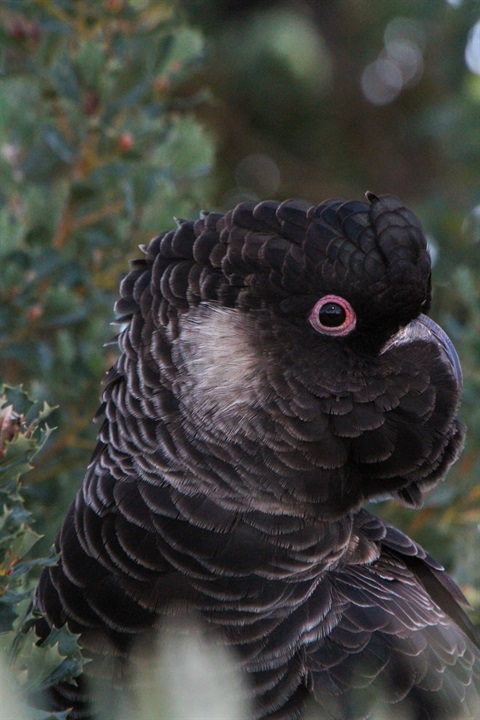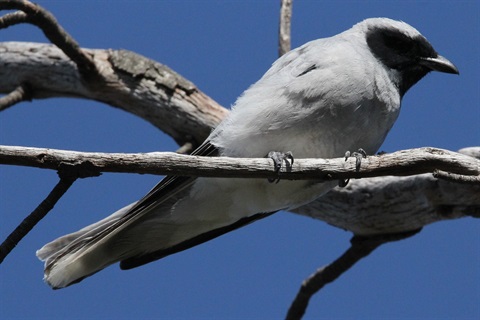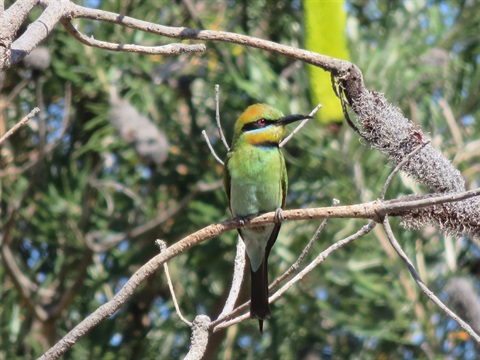Carnaby's Cockatoo
Calyptorhynchus latirostris
Noongar name: Ngoolark
Conservation status: Endangered, under both the Western Australian Wildlife Conservation Act and the Federal Environmental Protection and Biodiversity Conservation Act.
Distribution: Only found in the southwest of WA, from Kalbarri to Cape Arid.
Description:
The Carnaby's Cockatoo are 53 to 58 cm in length and weigh between 500 and 790 grams. They are distinguished from the similar Baudin’s Cockatoo by their upper bill which is broader and shorter. The males are mostly brownish black, the feathers tipped with dusky white giving a scalloped appearance with ear coverts that are dusky white and a bill black and a pink skin ring around eye. The female differs with ear coverts yellowish white a greyish white bill or grey with a black tip and grey skin ring around the eye.
Curious facts:
- Carnaby’s Cockatoo has been seen at this site from late summer through to autumn feeding on our Banksia, Jarrah and Allocasuarina seeds in small or large flocks wailing ‘weeloo-weeloo’ as they forage.
- Carnaby’s Cockatoo has become ‘endangered’ due to the large-scale clearing of both breeding woodlands in the wheat belt dominated by Salmon gum and Wandoo forests and feeding habitats on the Swan Coastal Plain (Banksia and Tuart woodlands).
- Sometimes mistaken for Baudin’s Black Cockatoo (Calyptorhynchus baudinii) with its longer upper bill that is used to break open their favorite food Marri nuts (Corymbia calophylla).
References
Neville, S.J 2013, Simon Neville Publications, Birds of Western Australia.
Dept of Parks and Wildlife fact sheet
WA Museum fact sheet

Black-faced Cuckoo Shrike
Coracina novaehollandiae
Noongar name: Ngoolako
Conservation status: Least concern
Distribution:
Common and widespread across mainland Australia and Tasmania. Also found in Indonesia, Papua New Guinea and Solomon Islands.
Description:
A medium sized (30-36cm) slender bird, the Black-faced Cuckoo Shrike has an almost uniform blue-grey body with a distinctive black facial mask and bib with black etching to their wings, juvenile birds differ slightly with a reduced black band across the eye. There are no viewable differences between sexes. Its call is a loud, harsh, yet musical decent of 'churrieer'.
Curious facts:
- Seen consistently throughout the year at Kensington Bushland hawking for insects in the tree canopy. Can often be seen perching prominently on the tops of dead branches or tree as these are vantage points before swooping down to take insects and other prey.
- Sometimes referred to as the ‘Shufflewing’, Black-faced Cuckoo-shrikes have a distinctive habit of shuffling their wings after landing.
- The Black-faced Cuckoo-shrike is known to choose the same mating partner every year and may use the same territory.
References:
The Graham Pizzey & Frank Knight Field Guide to the Birds of Australia, 1999 (pg 288).
Friends of Queens Park bushland
Life in the Suburbs

Rainbow Bee-eater
Merops ornatus
Noongar name: Birunbirun
Conservation status: Least concern
Distribution:
Widespread across most of mainland Australia, it is absent from the central deserts and from Tasmania (Higgins, 1999). Prefers lightly wooded areas with sandy/loamy soils. Southern populations undergo an annual migration during the winter months (April-September) to northern Australia, Papua New Guinea and Indonesia.
Description:
A striking, colourful bird, the Rainbow Bee-eater is medium sized, with a long slim curved bill and a long tail with distinctive tail-streamers. It has a golden crown and a red eye set in a wide black stripe from the base of the bill to the ears, which is edged with a thin blue line. The throat is orange-yellow, with a broad black band separating it from a green breast. The upperparts are green, with the flight feathers coppery and black tipped. The underwings are bright orange, with a black edge. The lower abdomen is blue. The tail is black, including the long tail streamers, with a blue tinge. Females have shorter, thicker tail streamers than males, but are otherwise similar. Young birds are duller and greener, lacking the black band on the chest and the long tail streamers.
Curious facts:
- Digs a nest in the firm flat sand or the side of a sandy bank, usually in very open areas and commonly seen in suburban areas.
- Catches dragon flies and bees on the wing then whacks against a branch before swallowing.
- This colourful migrant arrives at this site for breeding and feeding in the summer holidays and then flies northern Australia or as far as Papua New Guinea or Indonesia for winter.
- This small brightly rainbow coloured blue and green bird catches wasps and bees while airborne and removes the stings by bashing the insects against a branch before they can eat them.
- Animals are usually seen in pairs or small flocks. However, when they are migrating, individuals may occur in groups of 500 birds.
- Rainbow Bee-eaters are found in a range of habitats, including open woodlands, sand ridges, riverbanks, road-cuttings, beaches, dunes, cliffs, mangroves, rainforest, woodlands and golf courses.
- Even though rainbow bee-eaters are actually immune to the stings of bees and wasps, upon capturing a bee they will rub the insect's stinger against their perch to remove it, closing their eyes to avoid being squirted with poison from the ruptured poison sac. Bee-eaters can eat several hundred bees a day, so they are obviously resented by beekeepers, but their damage is generally balanced by their role in keeping pest insects such as locusts and hornets under control.
- Rainbow bee-eaters are believed to mate for life.
- They hardly ever need a drink as the insects they eat contain all the moisture they need.
- Look for Rainbow Bee-eaters on high perches such as power lines and dead treetops, where they have a good vantage point from which to spy bees and wasps. Listen for the high, melodic, repetitive trill. They catch insects on the wing and if you watch closely, you'll see the bee-eater rub or bash the bee against a branch to remove the pesky sting before gobbling them up.
References:
Higgins, P.J. 1999. Handbook of Australian, New Zealand and Antarctic Birds, vol. 4: Parrots to Dollarbirds. Oxford University Press, Melbourne, Australia.
